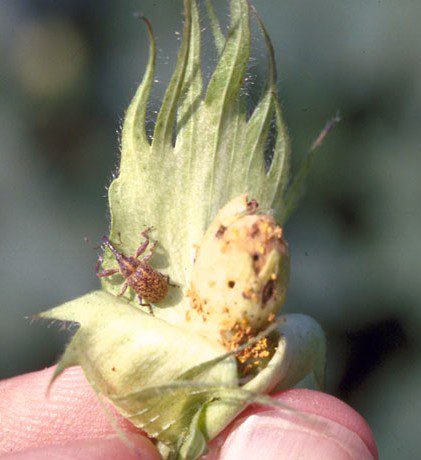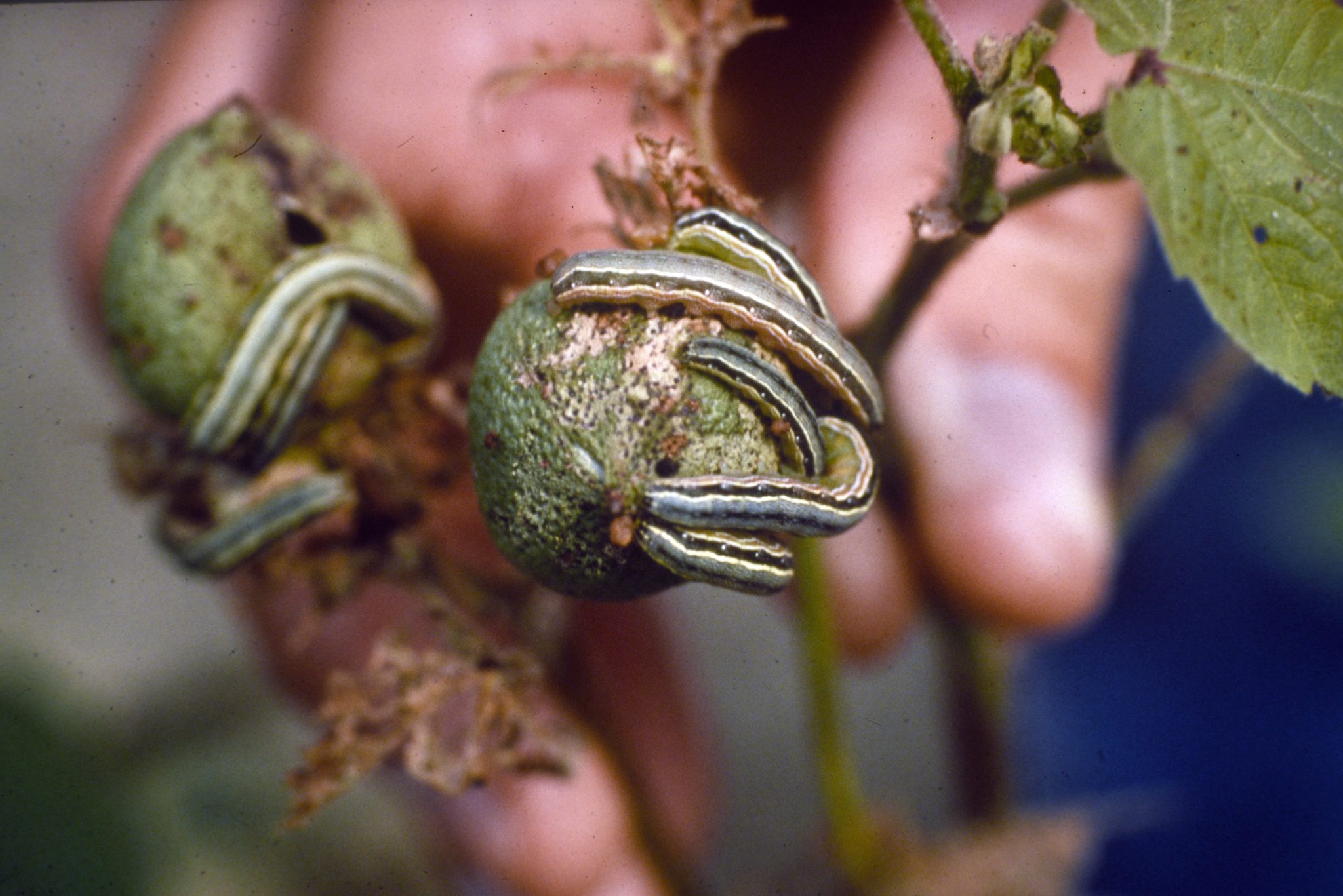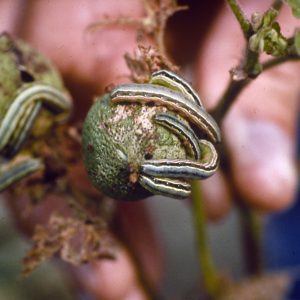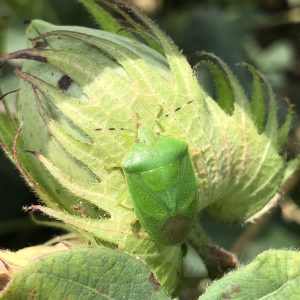Crop Production

Trace the history of insect pest management in Alabama cotton. Learn about the boll weevil, the rise of the caterpillar, integrated pest management, and the future of insect control on the state’s cotton.
Cotton production in Alabama can be traced to the late 1700s. Throughout the early and mid-1800s, production was focused on the Black Belt soils of west central Alabama. During this time, cotton was the primary driver of the state’s economy. Alabama cotton farmers faced few challenges they could not overcome until the Civil War, which devastated the state’s economy and cotton production for a variety of reasons. After the war, cotton made a comeback, and acres began to rise. Not long after this, however, came the event that would change cotton production in Alabama forever—the arrival of the boll weevil.
Boll Weevil Establishment

Figure 1. Adult boll weevil with damage on a square.
The boll weevil (figure 1) was first introduced to the United States from Mexico in 1892. At this time, Alabama was still recovering from the Civil War, and cotton yields were struggling to reach the peaks of the pre-Civil War era. Everything changed in 1910 when the first boll weevil was found in Mobile County. Although the boll weevil took some time to establish statewide, the impact in each county was felt as quickly as the pest appeared. In just 3 years, production went down 70 percent—a crop of more than 1.7 million bales was reduced to just 515,000 bales in 1917, the first year of the statewide presence of the boll weevil. Over the next 80 years, Alabama producers continued to grow cotton, but the economic impact of the weevil was high. During this time, Alabama cotton producers lost an average of 30 million dollars a year to this pest.
In the mid-1940s, not long after World War II, a new class of insecticides, the chlorinated hydrocarbons (or organochlorines) was introduced. These chemicals, better known as dichlorodiphenyltrichloroethane (DDT), toxaphene, and benzene hexachloride (BHC), were highly effective against weevils when they first were brought on the market. Applications of organochlorines had to be made at 4- to 7-day intervals to effectively reduce weevil damage. After about a decade, however, the weevil developed resistance to these insecticides.
In the early to mid-1970s, organophosphate insecticides were the primary chemicals used to manage boll weevils. They had fast activity but short residual and acute human and mammalian toxicity. To effectively manage boll weevils, insecticide applications had to be made at 5-day intervals. Although excellent at eliminating boll weevils, organophosphates’ heavy use led to resistance of tobacco budworms and often flared secondary pests. Over the years, yields peaked, and economic losses to insect pests were greatly reduced. During this period, the final plan to eradicate the boll weevil was put in place, largely out of fear that the weevil would develop resistance to the organophosphates as it had to the organochlorines decades before.
The late 1970s proved to be a pivotal point in cotton production and pest management in Alabama. This is when the pyrethroid class of insecticides was introduced. The extended residual control of pyrethroids lengthened spray intervals from 5 days to 7 days, providing control of nearly every cotton insect pest for several years.
The Boll Weevil Eradication Program started in September of 1987 across the southern portion of the state. Over the next 8 years, the program expanded north in four regional increments. By the summer of 1995, no economic losses to boll weevil were recorded in Alabama for the first time in more than 80 years. Gone, but not forgotten. A monument erected in 1919 in Enterprise, Coffee County, Alabama, is a memorial to the boll weevil (figure 2).
Rise of the Caterpillar
As is often the case when one pest is eradicated, a new one rises to become a major yield-limiting threat. With the bombardment of insecticides needed to eradicate the boll weevil came the elimination of beneficial insects and the rise of resistance, leading to high populations of tobacco budworms and beet armyworms (figure 3). These pests were responsible for up to 40 million dollars in loss annually during the late 1980s and early 1990s.
Everything changed in 1996 when the first genetically modified organism (GMO) cotton varieties went on the market. This GMO technology, referred to as Bollgard, expressing the Bacillus thruingiensis (Bt) toxin Cry1Ac, was readily adopted in Alabama. In the first year of commercial availability, Bollgard cotton was planted on 77 percent of the cotton acres statewide. Although growers no longer needed to spray for beet armyworms or tobacco budworms, issues with escaped bollworms became prevalent. As understanding of the Bt technology increased, growers were able to effectively manage escaped bollworms using a well- timed application of a pyrethroid. The following decade provided Alabama cotton producers with a low-spray, high-yielding environment with reduced input costs. A second Bt gene entered the market in 2009, and a third was added in 2014, with each addition further reducing the number of sprays required to manage bollworm.
- Figure 2. The Boll Weevil Monument in Enterprise stands as a reminder of the importance of this pest across Alabama.
- Figure 3. Infestation of beet armyworms, a key insect in Alabama cotton following boll weevil eradication.
- Figure 4. The stink bug has become the key insect pest of cotton in Alabama.
Alabama Cotton IPM Today
By the 2021 growing season, Alabama cotton producers were primarily planting varieties that express three Bt toxins, and sprays for escaped bollworms are rarely needed. However, in the low-spray environment in the decades following the introduction of Bt cottons, other pests have filled the void. The annual “bug complex” (stink bugs and plant bugs) is the most yield-limiting insect issue for Alabama cotton producers. Across most of north Alabama, the tarnished plant bug is the dominant insect pest. Adult plant bugs infest fields in early June, during the squaring period, and begin feeding on pinhead squares and laying eggs that will develop into embedded populations as the cotton begins flowering. When left untreated, plant bugs can cause devastating yield losses.
In central and south Alabama, it is the stink bug that is the key insect pest. Unlike plant bugs, stink bugs do not infest fields at economic levels until around the third or fourth week of bloom. This pest, which is hard to find in a field due to its skittish nature, targets developing seed in small bolls (figure 4). Since cotton cannot compensate for this mid- to late-season loss of developing bolls, timely insecticide use is critical for stink bug control. With proper scouting and the use of thresholds, Alabama cotton producers can effectively manage the bug complex and effectively reduce yield losses to these pests.
Sucking pests, such as thrips, aphids, silverleaf whiteflies, and spider mites, must be monitored and managed annually. A shift to reduced-tillage and cover- cropping systems has led to sporadic early-season pests such as grasshoppers, cutworms, snails, slugs, and early-season spider mites that also present problems. Although these secondary and sporadic pests require attention, only a few key pests cause major concern for Alabama cotton.
Future of Alabama Cotton IPM
The future of cotton insect pest management (IPM) is likely to be in the form of plant-incorporated protectants (PIPs) and more selective insecticides. For example, in contrast to the late 80s and early 90s when broad- spectrum insecticides, such as pyrethroids, were used to control caterpillar pests, most caterpillar insecticides used today have little or no impact on sucking pests or the bug complex. Often, tank mixtures of two or more insecticides are needed to overcome a pest complex or varying levels of resistance that insects have developed over the years. Advances in cotton genetics have always been a driver for the industry; however, discovering, researching, and developing new traits to provide insect control may take decades. A novel Bt trait controlling both thrips and plant bugs will be introduced to the market in coming years. Although not as revolutionary as Bt caterpillar technologies, this new trait will help Alabama producers reduce the need for insecticides to manage these pests. The key for Alabama cotton production and IPM will be to stay ahead of resistance and continue to develop ways to monitor and manage sporadic and secondary pests.
 Scott H. Graham, Extension Specialist, Assistant Professor, Ron Smith, Professor Emeritus, both in Entomology and Plant Pathology, and Steve Brown, Extension Specialist, Assistant Professor, Crop Soil and Environmental Sciences, all with Auburn University
Scott H. Graham, Extension Specialist, Assistant Professor, Ron Smith, Professor Emeritus, both in Entomology and Plant Pathology, and Steve Brown, Extension Specialist, Assistant Professor, Crop Soil and Environmental Sciences, all with Auburn University
New November 2021, History of Insect Pest Management in Alabama Cotton, ANR-2831




